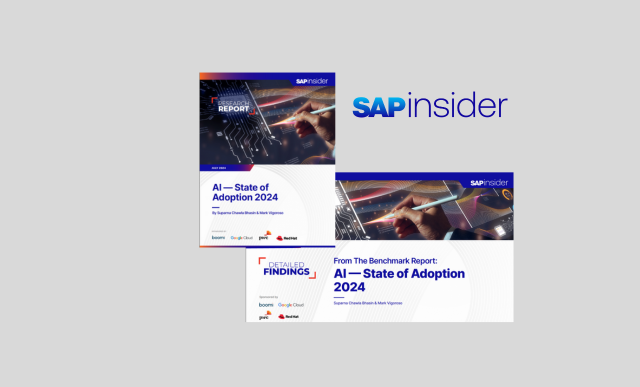Microsoft and SAP Spotlight AI innovation at SAPinsider Las Vegas 2025
Meet the Authors
Key Takeaways
⇨ Microsoft and SAP are actively collaborating to integrate AI into enterprise environments, fostering strong demand and curiosity among customers for tools that enhance productivity, such as bidirectional copilots integrating Microsoft 365 Copilot and SAP Joule.
⇨ Practical AI tools are already available, allowing users to access SAP data through Microsoft Teams without needing to understand transaction codes, demonstrating immediate value despite ongoing development of deeper integrations.
⇨ Customer feedback is crucial to shaping future AI solutions, encouraging businesses to engage with Microsoft and SAP to influence product development and to invest in data architecture to fully leverage forthcoming AI capabilities.
Artificial intelligence was at the forefront of SAPinsider Vegas this year, where Microsoft and SAP showcased their deepening collaboration on next-generation enterprise AI. In an exclusive conversation with SAPinsider, Imran Rashid, Director of SAP on Azure Global Blackbelt at Microsoft, detailed how joint development efforts are shaping the future of SAP and Azure integration—and how customers are responding.
Rashid, who leads industry verticals like manufacturing and the public sector in Microsoft’s SAP on Azure Global Blackbelt organization, attended the event to connect with customers and present the session “Microsoft AI for SAP Applications.” His mission: to explain what’s possible now and what’s coming next in AI for SAP workloads on Azure.
Strong Demand, Clear Curiosity: AI Meets Enterprise Need
“The traction or the interest in AI combining with SAP applications—that’s phenomenal,” Rashid said. “It was a full house.” Attendees were especially interested in understanding what’s available today and where the roadmap is heading, particularly when it comes to integrating Microsoft AI services with SAP systems.
Explore related questions
At Microsoft’s booth, Rashid fielded questions from a wide range of customers. “People want to see something in action,” he said. “That’s why we had demo scenarios ready, and we invited audiences to stay afterward to experience those capabilities firsthand.”
The Next Frontier: Bidirectional Copilots with SAP Joule
A highlight of Microsoft’s strategy is its joint development with SAP on bidirectional copilot integration—enabling Microsoft 365 Copilot and SAP Joule to seamlessly exchange data and context.
“Today, SAP has Joule and Microsoft has its own Microsoft 365 Copilot, but they don’t cross-reference each other. That creates confusion for users,” Rashid explained. “We aim to enhance productivity and streamline operations by developing copilots that are intelligent enough to seamlessly understand and collaborate with each other.”
He painted a practical scenario: “Let’s say I have a delayed sales order in SAP. Half the information might live in SAP, but the rest—maybe the manufacturer’s delay notice—is in my Teams chat or email. Our bidirectional copilot would be smart enough to pull it all together, across platforms, and deliver it in one cohesive response.”
Microsoft is the only vendor currently co-developing this kind of cross-platform copilot functionality with SAP. “That stands out,” Rashid said. “No other vendor is doing this joint bidirectional Joule integration.”
AI in Action: Tools Available Now
While Joule integration is still in development, Microsoft offers tangible AI-powered tools today. “You can try Teams integration now,” Rashid said. “Ask Teams to show you a sales order from SAP. As a business analyst, you don’t need to log into SAP or know transaction codes—Teams will return the data directly.”
He also highlighted custom copilots, built with low-code tools that connect Microsoft interfaces to SAP data, and functional copilots specialized in areas like finance and HR. “Think of them as assistants with deep domain knowledge,” Rashid noted. “A finance copilot can reconcile data from two ERPs. An HR copilot can support talent acquisition workflows.”
How Microsoft is Addressing Customer Hesitation
Despite growing interest, Rashid acknowledged that customers are still figuring out how to adopt these emerging technologies. “AI relies on data,” he said. “And customers are still wrapping their heads around how it works, what services are needed, and how to build the right architecture.”
He compared AI onboarding to “peeling an onion”—layer by layer. “We start with fundamentals, then move to use cases, and then ask: What manual tasks can we automate to improve quality and reduce errors?”
In his presentation, Rashid also showcased the power of Azure OpenAI Services, including the O1 model for advanced forecasting. “For example, a retailer could ask the model to build an inventory plan for the next seven days. It will factor in local weather, events, traffic—whatever impacts demand,” he said. “It’s a complex process, simplified through AI.”
Shaping the Future Together
Microsoft isn’t dictating the roadmap. It’s building it with customer input. “We’re asking customers: What do you want these tools to do?” Rashid said. “Their feedback helps us refine the integration points and make sure the solutions we deliver solve real business problems.”
It’s a collaborative effort between Microsoft, SAP, and the enterprise community. With its unmatched bidirectional copilot development and robust AI toolkit, Microsoft is positioned to play a leading role in shaping how businesses harness AI within SAP environments.
“Customers are interested,” Rashid concluded. “They’re engaged. And they’re ready to see what’s next.”
What this means for SAPinsiders
Start exploring AI through existing Microsoft integrations with SAP. While bidirectional copilots are still on the horizon, practical AI tools like Microsoft Teams integration with SAP are available now. Business leaders should evaluate how these tools can simplify workflows by enabling non-technical users to access SAP data without needing to navigate traditional interfaces or transaction codes. Early adoption of these features can lay the foundation for more advanced AI use cases down the line.
Collaborate on use cases to shape future AI solutions. Microsoft is actively co-developing AI functionality—like SAP Joule and Microsoft Copilot integration—based on customer-provided scenarios. Decision-makers should engage with Microsoft and SAP to share their business challenges and use cases, influencing product development while ensuring upcoming tools meet real enterprise needs. This participatory approach can accelerate innovation and adoption tailored to your operations.
Prepare your data and security architecture now. AI effectiveness depends on secure, high-quality, and well-structured data. To capitalize on forthcoming AI features like functional copilots and predictive planning via Azure OpenAI Services, organizations should invest in robust data governance and integration strategies. Ensuring your data estate is AI-ready will allow you to move quickly when these advanced capabilities become generally available.






